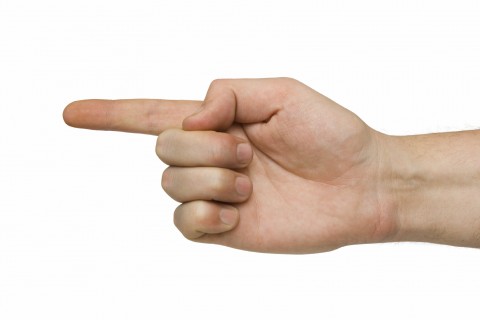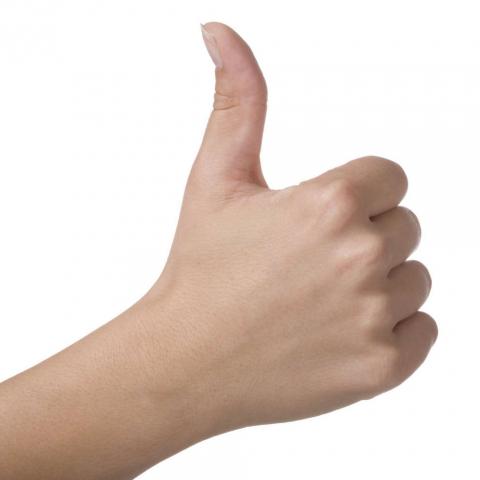
What’s the most important thing you focus on in your language studies? Is it grammar? Are you drilling in dozens of rules until your head hurts? Or do you prefer a more relaxed, “organic” approach, and base your learning sessions on fun videos, smart apps, and podcasts? Both methods work, but the latter might yield better results…in a much shorter time.
Many people think that in order to learn a foregin language (Czech in this case), you must master the grammar and memorize vocabulary, which is true in a way—but things like Czech gestures and body language are important too.
The essence of any language lies in details that many students and teachers (even the seasoned ones) tend to dismiss as unimportant. Yet, when you’re talking to someone in your first language, these little factors—like the tone of your voice and your gestures—matter almost as much as the words you’re saying. Am I right?
Here’s an example:
A couple of months ago, during a not-so-pleasant FaceTime conversation with my boyfriend, he said something, and I shrugged in response. He was baffled.
“Oh, so you don’t care.”
Truth is, I did care, I just didn’t know what to say, and that’s exactly what my shrug was supposed to express––”I have no idea what to do or say.”
His American brain read the gentle raise of my Czech shoulders as, “I couldn’t care less.”
Being able to read people’s movements and gestures correctly will not only prevent misunderstandings. It will also help you “read minds,” understand your partners’ perspective, and (I’m almost ashamed to share this because it works like magic) it will help you get what you want. There, I said it. If you’re interested in this modern era witchery, read The Art of Reading Minds and the good old classic How to Win Friends and Influence People. It might change your life.
Let’s learn how to translate Czech body language, gestures, and their real meaning. Have fun!

How can you use your fingers to communicate without words? You’ll find out in this article.
 Table of Contents
Table of Contents
- How to Become a Mindreader: Body Gestures in the Czech Republic
- Don’t You Point at Me, or Else: Hand Gestures and Etiquette in the Czech Republic
- How CzechClass101.com Can Help You Learn Czech in a Fun Way
1. How to Become a Mindreader: Body Gestures in the Czech Republic
First things first: Your mamma was right when she kept bugging you about the importance of a strong stance.
- ➢ The way you’re standing or sitting says a lot about your mood and personality. It’s a very prominent and important nonverbal signal that’s an integral part of our communication.
You probably know this, but I’m going to run through the basics, just to make sure we’re on the same page.
- Crossed arms: This closed-off position indicates defensiveness or self-protectiveness, like you’re trying to build a wall between yourself and others.
- Crossed legs: Pretty much the same as crossed arms, this posture can also indicate unfriendliness or even hostility and anxiety.
- Hands on your hips: You’re ready to conquer the world and jump into action (though it might indicate aggressiveness as well).
- Knees apart while sitting: You’re in a great mood, aren’t you? You feel good, you’re open, and you’re willing to communicate.

“I am willing to communicate with you, but I have other plans. Bye.”
Body language matters, but it won’t hurt to learn how to express your feelings in words as well.
Typical Czech Body Language Gestures
I’ve mentioned this many times and I’m going to say it again: Czechs are very reserved.
We don’t appear super-friendly (nor is it our intention to), and when you come to the Czech Republic, you’ll encounter a lot of:
- Crossed arms and legs.
- Personal distance like there’s a pandemic going on—standing close to one another is a sign of trust and intimacy, so don’t try to get closer than five feet.
- Hip pats as a sign of defeat or helplessness (“I don’t know what to do”). We raise our arms and pat our hips—the more desperate the situation, the louder the pat.
- Shoulder raises (a.k.a the confusing shrug). This might indicate “I don’t care” (we use a different hand gesture in such situations, but we’ll get to that later), but for us it’s mostly a sign of confusion, helplessness, or even defeat. When in doubt, always assume it’s “I have no clue” rather than “I don’t give a damn.”
Other than that, we move, slouch, and stand tall just like any other nation in the Western world.
Here’s a little something-something that textbooks won’t mention, a few words of wisdom from your Czech writer:
- ➢ Nehrb se! – “Stop slouching!”
➢ Narovnej se! – “Straighten your back!”
➢ Jdi ode mě! – “Get away from me!”
If you struggle with the Czech words for body parts, this reading lesson might help.
2. Don’t You Point at Me, or Else: Hand Gestures and Etiquette in the Czech Republic
This part is going to be crucial if you really want to understand the Czech clues and hints without saying (or hearing) a single word.
There are certain peculiarities about gestures and body language in the Czech Republic that might confuse an inexperienced foreigner. Let’s start with those.
A- Order a Beer Like a Czech (or German, or Frenchman, or…): Counting
Have you seen Tarantino’s Inglourious Basterds? Remember what happened to the poor guy who was pretending to be a German soldier and gave away his secret by holding up his fingers the wrong way when ordering drinks?
I’m not saying you’d get hurt if you held up your index finger while telling your friend you’ve only been to Disney World once. However, this is an important component of Czech gestures you should learn before visiting the country:
- If you hold up your index finger (the English signal for “one” or “once”), an average Czech will read this as: “Now listen to me, I have something important to say.” Or: “Wait a minute, I want to say something but I’m too polite to cut you off.”
- “One” is very often indicated by the “thumbs-up” sign––the same gesture we use for “Everything is great.” Important detail: Don’t point your fist directly at your partner; your palm should be facing your chest, so that the other person sees only the heel of your hand and your thumb.
- “Two”: You hold up your thumb and index finger. Again, your palm is facing your chest. Just don’t point at anyone with your fingers like that. THAT sign is universal.
- “Three”: Stretch out your thumb, index finger, and middle finger. You already know the rule about the palm, don’t you?
- The rest is the same as in English nonverbal communication.
Can you count in Czech? Great! You can’t? Here, problem solved.

“Just one. Also, everything is great, thanks for asking.”
B- I Don’t Wanna Fight, I’m Wishing You Good Luck: Czech Hand Gestures
- “You’re dumb.” If you want to tell someone that you’re questioning their intelligence, just point to your temple or forehead and tap it lightly. They’ll know. Then… Maybe run. If you’re on a date, prepare to pay for both of you and leaving the restaurant alone.
- “You’re being a bad boy/girl.” This gesture is sort of “parental,” but you might see it occasionally––like if you’re comfortably seated on a crowded train, intending to keep your cozy position, and an old-but-fierce lady gets on. She would wag her index finger, give you a scolding look that would make your blood run cold, and complain about ta dnešní mládež (“kids these days”).

Remember that bad boys don’t get a dessert. Is it still worth it?
- “Good luck!” We don’t cross our fingers. We prefer to scare you with a closed fist with the thumb neatly tucked inside. Držím ti pěsti or Držím ti palce, the Czech expression for “fingers crossed,” literally means “I’m holding my fists for you,” or “I’m holding my thumbs for you.”
- “I don’t want to jinx it!” Fingers crossed your wish still comes true even though you just told your bestie. If you happen to see an older person knocking on the wood/their forehead/YOUR forehead, they’re performing this superstitious mini ritual as well.
- The obscene gesture. If you care about the meaning of gestures and etiquette, just don’t use this one. Ever. If you ever see someone slapping their closed fists with their palm, remember that not all people are as sophisticated as you.
- “I’m begging you, don’t make me see your grandma ever again.” If you’re not a big fan of your significant other’s family member or if you’re in real trouble, rub your palms together (like in a prayer).

Please don’t make me do stuff.
- “I’m a malicious monster and your bad luck just made me very happy.” A.k.a kyš-kyš (an untranslatable sound rather than a word) shows the world that you love when someone fails. Rub the top of your index finger with your other index finger, sort of like if you were mimicking a grating motion—and don’t forget to stick out the tip of your tongue for that extra oomph. Speaking of which, can you describe your personality in Czech?
- “That? That was nothing.” We wave things off a lot. We like to act like they’re just tiny little flies that disappear when we swing our powerful palms nonchalantly, almost like a little kitty playing with an invisible toy on a string. Just a single wave though, you’re not waving that insignificant triviality goodbye, you’re trying to make it go away.
- “Hmmm, let me think about that.” If you hold up your index finger and touch it lightly to your lips or chin, everyone in the room will know you’re in deep thought. Pro-tip: Do this if you need to buy some time because you’re not sure what to say. It’s been working for me for over 30 years, so you might find it useful as well.

“Can’t you see that I’m thinking?”
Okay guys, this is it, I think you can roam the Czech Republic without making a faux pas or staring at a flustered native in disbelief and utter confusion. It might be a good idea to learn a little more about the Czech culture, traditions, and trends as well.
Go explore, I’m holding my thumbs for you!
3. How CzechClass101.com Can Help You Learn Czech in a Fun Way
Stop trying to learn Czech. Learn Czech. Get smarter tools, study smarter, and believe in yourself. The sky’s the limit!
I hope you enjoyed this article and learned something new! In case this wasn’t enough for you, please check out our Basic Bootcamp, which covers the very basic grammar and vocab in five compact lessons.
If you’re taking learning Czech seriously, you might grab a Czech grammar book or learn online (the latter of which is way more convenient). Learning a new skill has never been easier. Just grab your phone and get to work!
CzechClass101.com makes learning Czech easy, exciting, and fun. With us, it’s not about endless memorizing or thick textbooks. Learn Czech the better way—with us, you’ll make progress faster than you could imagine!
What can you find here?
- English-to-Czech translation and pronunciation tips/tricks
- Over 630 audio and video lessons
- Vocabulary learning tools
- Spaced repetition flashcards
- Detailed PDF lesson notes
Sign up now, it’s free!
Let us know if you liked this article and share your fun stories about gestures and body language in the Czech Republic. We’d love to hear from you!










